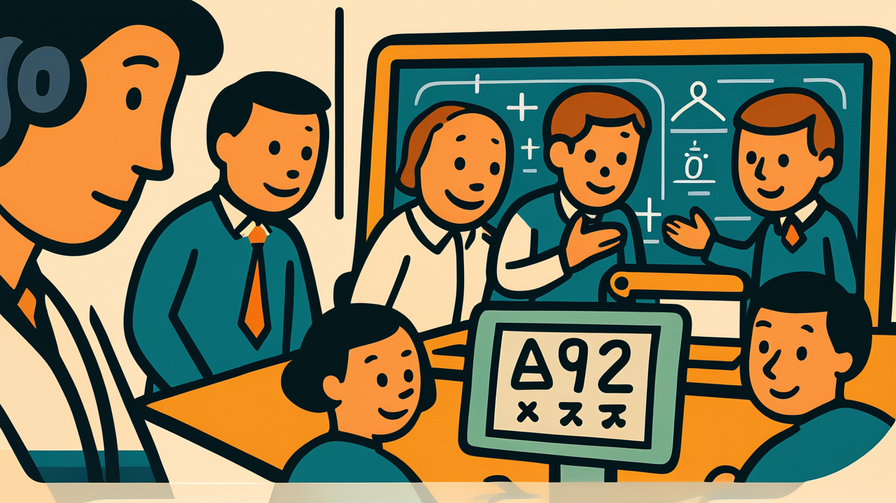[Disclaimer] This article is reconstructed based on information from external sources. Please verify the original source before referring to this content.
News Summary
The following content was published online. A translated summary is presented below. See the source for details.
NVIDIA has released NeMo-RL, an open-source library that uses reinforcement learning to train AI models to solve complex problems. The post demonstrates how to reproduce a DeepScaleR recipe using Group Relative Policy Optimization (GRPO) to train a Qwen-1.5B model to match OpenAI O1’s performance on difficult math problems. NeMo-RL is designed to scale from single-GPU prototypes to thousand-GPU deployments, featuring native integration with Hugging Face models and flexible backend architecture. The library supports multiple training and generation backends, including vLLM for generation and PyTorch for training. The tutorial shows a three-step process: gradually increasing context lengths from 8K to 16K to 24K tokens while training. Results show the model achieving a training reward of 0.65 in just 400 steps and eventually surpassing OpenAI O1 on the AIME24 mathematics competition benchmark. This demonstrates how reinforcement learning can teach AI models to reason through complex problems using long chains of thought, similar to how humans work through difficult math problems step by step.
Source: NVIDIA Developer Blog
Our Commentary
Background and Context

Think about how you learned to ride a bike. You didn’t just read about it—you tried, fell, got back up, and gradually got better through practice. That’s essentially what reinforcement learning (RL) does for AI. It’s a way of teaching computers by letting them try things, learn from mistakes, and get rewards for doing things right.
NVIDIA’s NeMo-RL is like a training gym for AI models, where they can practice solving really hard problems—especially math problems that would challenge even the smartest students. The goal is to create AI that doesn’t just memorize answers but actually learns to think through problems step by step, just like a human mathematician would.
Expert Analysis
What makes NeMo-RL special is how it teaches AI to use chain-of-thought (CoT) reasoning. Imagine solving a complex math problem—you don’t jump straight to the answer. You work through it step by step, checking your logic along the way. That’s what these AI models are learning to do.
The clever part is the training strategy. Just like you wouldn’t start learning math with calculus, NeMo-RL starts with shorter problems (8K tokens, or about 6,000 words) and gradually works up to longer ones (24K tokens, or about 18,000 words). This gradual approach is like training for a marathon by first running 5K, then 10K, then half-marathons.
The GRPO (Group Relative Policy Optimization) algorithm is the secret sauce. It’s like having a really smart coach who knows exactly when to push the AI harder and when to let it consolidate what it’s learned. This helps the AI improve much faster than traditional training methods.
Additional Data and Fact Reinforcement
The results are genuinely impressive:
• Achieved a training reward of 0.65 in just 400 steps (very fast learning!)
• Eventually surpassed OpenAI O1 on AIME24 (American Invitational Mathematics Examination)
• Scales from 1 GPU to 1,000+ GPUs seamlessly
• Works with models up to 32 billion parameters (that’s a lot of artificial “brain cells”!)
The AIME is no joke—it’s a prestigious math competition for high school students where even getting a few problems right is considered excellent. The fact that this AI can compete at that level shows how powerful reinforcement learning can be.
Related News
This development is part of a larger trend where AI companies are moving beyond simple question-answering to models that can truly reason. OpenAI’s O1 and DeepSeek-R1 are similar “reasoning models” that think through problems rather than just pattern-matching.
The release of NeMo-RL as open source is significant because it democratizes access to these advanced training techniques. Previously, only big tech companies had the resources to train reasoning models. Now, researchers and smaller companies can experiment with these methods, potentially accelerating AI development across the board. This follows NVIDIA’s strategy of providing tools that help the entire AI ecosystem grow.
Summary

NeMo-RL represents a major step forward in teaching AI to think, not just memorize. By using reinforcement learning to train models on complex math problems, NVIDIA has created a tool that can produce AI capable of step-by-step reasoning at competition levels.
For students interested in AI, this shows how the field is evolving. We’re moving from AI that simply retrieves information to AI that can work through problems methodically. The fact that it’s open source means that tomorrow’s AI developers—maybe including you—can use these same techniques to create even smarter systems. Whether you’re interested in math, science, or any field requiring complex reasoning, tools like NeMo-RL are paving the way for AI assistants that can truly help us think through difficult problems.
Public Reaction
The AI research community has responded enthusiastically to NeMo-RL’s release. Developers appreciate the seamless integration with Hugging Face models and the ability to scale from small experiments to massive deployments. Some researchers have already started experimenting with the DeepScaleR recipe, sharing their results online. However, some note that the computational requirements for training these models remain high, limiting access to those with significant GPU resources. The open-source nature has been particularly praised, with many seeing it as a positive step toward democratizing advanced AI research.
Frequently Asked Questions
Q: What’s reinforcement learning in simple terms?
A: It’s like training a pet—you reward good behavior and the AI learns to repeat actions that lead to rewards. Over time, it gets really good at achieving its goals.
Q: Why is solving math problems important for AI?
A: Math requires logical thinking and step-by-step reasoning. If AI can master this, it can apply similar reasoning to other complex problems in science, engineering, and daily life.
Q: Can anyone use NeMo-RL?
A: Yes! It’s open source, meaning free to use. However, you need access to GPUs (special computer chips) to run it effectively, which can be expensive for large models.


